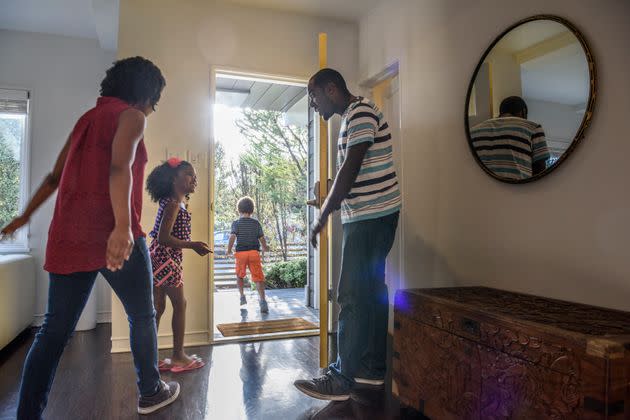How Soon Is Too Soon To Become Attached To Your New Partner’s Children?
- Oops!Something went wrong.Please try again later.
Despite Kanye West's vehement disapproval, photos show that Pete Davidson has met Kimye’s kids. (Photo: Marc Piasecki / Dimitrios Kambouris / Getty)
For parents dating again, figuring out when to introduce a new partner to your kids is a tricky calculus: How many months should you wait? Does the relationship feel stable and safe enough to take that step? Is your child emotionally ready to meet someone new since you split from your co-parent? What will your ex say?
The stress doesn’t end there; once the introductions have been made, you need to check in with your kids to make sure it’s all not too much, too fast, and that they’re comfortable around your new partner.
This common post-divorce dilemma has played out on a very public stage in recent months, since reality star Kim Kardashian has started dating “Saturday Night Live” comedian Pete Davidson.
Things seem to be going swimmingly for the new couple, but Kardashian’s ex, Kanye West, has expressed concern about Davidson’s relationship with his kids. (At one point West even dramatically wrote, “NO YOU WILL NEVER MEET MY CHILDREN” on an Instagram post.)
Still, photos taken recently show that Davidson has met the couple’s kids. And earlier this month, another photo popped up showing what appears to be a new tattoo for the comedian: The ink reads “KNSCP,” letters many fans believe stand for Kardashian’s four children with West: North, Saint, Chicago, and Psalm.
If the tattoo is real ― and Davidson does have a history of getting tattoos for the women in his life, including a branding in dedication to Kardashian ― it’s a showy display of commitment on his part.
Family therapists we spoke to wondered just how committed a person could be after roughly six months of dating.
“The tattoo seems more like evidence of his impulsivity rather than his genuine attachment to his girlfriend’s kids, which he could not possibly have in any substantive way after only six months,” said Virginia Gilbert, a Los Angeles-based therapist specializing in high-conflict divorce.
“I think six months is too soon to meet her kids, especially with an in-process messy divorce and Kanye being so opposed to the meeting, but everything Kim does is in the public eye, it would have been hard to keep Pete a secret, so the question is probably moot,” she added.
Kurt Smith, a family therapist in Roseville, California, who mostly works with men, said that the desire to connect deeper with your significant other by showing interest in their kids is understandable.
Ultimately, though, new partners need to recognize that it’s a delicate dance ― one that usually requires a healthy distance.
“Pete should be asking himself why that was so important for him to do at this stage of the relationship,” he said.
Since this co-parenting quandary is top of mind for many right now, we decided to ask family therapists and other experts on blended families to share the advice they’d give to parents newly dating again like Kardashian. Here’s what they said.
First off, when should introductions be made?
For divorced parents, when to introduce and involve a new partner in children’s lives is a complex question, with no “one size fits all” answer.
For some people, six months is enough; for others, a slower approach might be necessary, said Dawn O. Braithwaite, a professor of communication studies at the University of Nebraska-Lincoln.
Braithwaite has spent her career studying how families interact to create, navigate and change relationships, routines and traditions, especially in stepfamilies and chosen families.
According to her, parents need to consider the following six things before making introductions:
What they believe will be the future of their new relationship
The age of the children
How long it’s been since the separation or divorce
How well children have adjusted to changes in their family situation
The relationship with the co-parent
The interest the new partner has in meeting the kids
“While there are exceptions, most scholars have found that new partners can play a positive role in children’s lives, but that they should go slow and act as a friend for children rather than overstepping and acting in ways that are confusing or inappropriate for children,” the professor said.

“While there are exceptions, most scholars have found that new partners can play a positive role in children’s lives, but that they should go slow and act as a friend for children," said Dawn O. Braithwaite, a professor at University of Nebraska-Lincoln who studies stepfamilies. (Photo: Johnny Greig via Getty Images)
Meetups should be casual at first.
To avoid coming on too strong or overstepping boundaries, keep those early getting-to-know-you meetups as casual as possible: Arrange a park date or meet up for a Marvel movie and pizza.
“The onus needs to be on the new partner to meet the kids where they are ― meaning you need to participate in the kinds of things they like to do,” Gilbert said. “I would also suggest postponing adult sleepovers until the kids become comfortable with the new partner.”
Remember that your relationship is not with your partner’s kids — it’s with your partner only.
If you’re the parent, reinforce that you’re not a package deal ― not yet, anyway.
“Maintaining this boundary is important for both partners, the health of the new relationship, and, most importantly, for the kids’ health,” Smith said.
Move too quickly and you could quickly incur the annoyance of the kids ― and the potential ire of the other parent.
“I’ve counseled divorcing parents where his new girlfriend posted pics on social media of his kids at a birthday party like they were her own and believe me, it did not go over well with the other parent,” Smith said.
“It’s hard enough bringing in new partners and blending families, so avoiding anything that could cause tension or conflict should be avoided,” he explained.
Be comfortable being an outsider for a while.
Kids in situations like this are usually grappling with competing, confusing concerns, said Amy Begel, a family therapist in private practice in New York City and author of the blog Most Human: “Will they betray their father if they have a relationship with this new guy? Will they betray their mother if they are loyal to their father and want to protect his feelings?”
That’s why it’s important to take a backseat for a bit if you’re the new partner. It may feel like a blow to the ego to be treated as marginal, or worse, an intruder, but patience during this process is crucial, Begel said.
As Jenna Korf, a stepmom and founder of StepmomHelp.com, previously told HuffPost, you’re an outsider joining an already-formed family ― even if your partner and their kids eventually move into your home.
“A lot of this is unintentional, but kids automatically go to their parent,” she said. “You might be sitting right next to your partner and they won’t address you, often leaving you out of the conversation.”
If you’re the new partner, take the approach of a new friend or neighbor, not an automatic stepparent.
New partners should try to befriend the kids, but move at a pace determined by the kids, said Ron Deal, the founder of SmartStepfamilies.com and author of a number of popular books on blended families.
“In my book with Dr. Gary Chapman, ‘Building Love Together in Blended Families,’ I tell stepparents it’s like making friends with a new neighbor,” Deal said. “You don’t just push your way into their house and tell them you’re their new BFF. That makes enemies.”
Instead, the stepdad and author advised, you knock and wait patiently on the doorstep.
“You may even have to talk to them through the door for a while until you find a few things you have in common. Only when they open it can you begin to connect face to face,” Deal said. “Slowly, over time, a friendship is made that stands on its own terms.”

Meeting for the first time? Keep it casual. Think: The new Marvel movie on Disney+ and pizza at home where you get a chance to talk and get to know each other. (Photo: mixetto via Getty Images)
Avoid “erase and replace” messages if you’re the new partner.
According to Deal, exaggerated gestures like Davidson’s tattoos send the wrong message to kids. The goal for new partners is to come across as additive rather than substitutive: The kids should feel like they’re potentially adding to the family, not getting a substitute dad or mom.
“Pete’s tattoo may sound romantic ― that’s the kind of thing people do to win the affections of their dating partner ― but to the children it declares, ‘You’re mine.’” Deal said. “Someone might say, but isn’t that great as well? Not necessarily to a child. In their world, it may seem like Pete is trying to ‘erase and replace’ their father.”
A child’s loyalty lies, understandably, with their biological parent, not the new stepparent. A message like that threatens their relationship with their father “may partially explain Kanye’s strong reaction and only escalates the battle between the parents,” Deal told HuffPost.
“Here’s my rule of thumb: a new partner who tries to erase and replace a biological parent is, in fact, going to be erased and replaced themselves,” he said.

"As a general rule, it takes at least two years before a new partner can assume a traditional parenting role," said Virginia Gilbert, an LA-based therapist specializing in high-conflict divorce. (Photo: FatCamera via Getty Images)
Most kids with newly divorced parents are dealing with abandonment issues; don’t add to them.
It’s awful for a child to get attached to a new partner who then disappears from their lives. If your partner is coming on too strong with the kids, Gilbert said to acknowledge that this is a tough transition for everyone and tell them you really appreciate their efforts.
Then, shift the conversation: Try to encourage them to see things from the kids’ perspective: Among other things, your kids may be feeling extra loyal to your ex or they may be experiencing grief that their parents are no longer together. They may not want to share you with a new person and they may not want someone to have control over changes in their lives.
“Your new partner needs to understand how overwhelming your relationship might feel to the kids and that their ambivalence is not about them,” Gilbert said. “If the issue is creating conflict between you and your new partner, consider seeing a therapist who can help you both make child-centered decisions.”
The big takeaway here, though, is to take things slow: “As a general rule, it takes at least two years before a new partner can assume any sort of traditional parenting role,” Gilbert said.
Also on HuffPost
This article originally appeared on HuffPost and has been updated.
